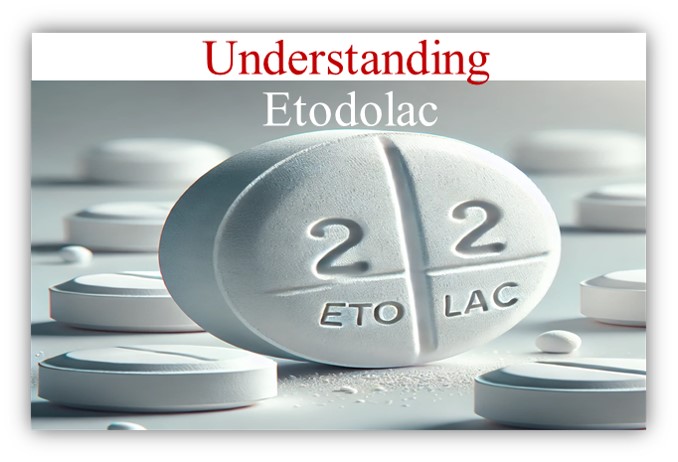OVERVIEW
Etodolac is a nonsteroidal anti-inflammatory drug (NSAID) commonly used to treat pain and inflammation associated with osteoarthritis, rheumatoid arthritis, and sometimes post-operative pain.

DOSAGE
| Condition | Patient Type | Dosage | Frequency | Maximum Daily Dose |
| Osteoarthritis / Rheumatoid Arthritis | Adults | 300 mg or 400 mg | Twice daily (BID) or once daily for extended-release | 1,200 mg |
| 500 mg | Twice daily (BID) | 1,200 mg | ||
| 600 mg | Once daily (extended-release) | 1,200 mg | ||
| Acute Pain | 200 mg to 400 mg | Every 6 to 8 hours as needed | 1,000 mg (short-term use) | |
| Juvenile Rheumatoid Arthritis | Children (6 years and older) | 13.3 mg/kg | Twice daily (BID) | Varies based on weight |
MECHANISM OF ACTION
COX inhibition:
Etodolac primarily inhibits the enzyme COX-2, which is heavily involved in inflammatory processes. However, it also has some activity against COX-1, which is involved in protecting the stomach lining and maintaining kidney function. This selective inhibition of COX-2 reduces inflammation and pain and the risk of gastrointestinal side effects is somewhat lower than with non-selective NSAIDs.
Reduction of prostaglandin synthesis:
By inhibiting the COX enzyme, etodolac reduces the production of prostaglandins. Lower levels of prostaglandins result in reduced inflammation, pain and fever.
Analgesic and anti-inflammatory effects:
Through the reduction of prostaglandins, etodolac provides relief from pain and inflammation associated with conditions such as osteoarthritis, rheumatoid arthritis and post-operative pain.
SIDE EFFECTS
Common side effects
- Gastrointestinal problems: Nausea, indigestion, stomach pain, heartburn, and diarrhea.
- Dizziness: Some individuals may experience mild headache or dizziness.
- Headache: Mild to moderate headache.
- Drowsiness or fatigue: Feeling tired or sleepy.
- Skin reactions: Mild rash or itching.
Less common but notable side effects
- Fluid retention: Swelling (edema) in the hands and feet due to water retention.
- High blood pressure: NSAIDs can sometimes raise blood pressure.
- Photosensitivity: Increased sensitivity to sunlight, leading to easier sunburn.
- Appetite changes: Some people may have a loss of appetite.
- Mild weight gain: Related to fluid retention in some cases.
Serious side effects (seek medical help immediately)
- Gastrointestinal bleeding: Symptoms may include black or bloody stools, vomiting blood, or severe stomach pain.
- Cardiovascular risks: The risk of heart attack, stroke, and blood clots is increased, especially with high doses or long-term use.
- Kidney impairment: Symptoms include decreased urine volume, swelling in the legs, and fatigue. NSAIDs can reduce blood flow to the kidneys, potentially causing damage.
- Liver problems: Symptoms may include yellowing of the skin or eyes (jaundice), dark urine, and pain in the upper right side of the abdomen.
- Severe skin reactions: Rare but serious skin reactions such as Stevens-Johnson syndrome or toxic epidermal necrolysis, which is marked by severe rash, blistering, and peeling.
- Allergic reactions: Swelling of the face, lips, or throat, hives, difficulty breathing.
DRUG-DRUG INTERACTIONS
- Anticoagulants: Increased risk of bleeding. Etodolac may enhance the anticoagulant effect of these medications, increasing the chance of bleeding complications.
- Antiplatelet Agents: The risk of gastrointestinal bleeding increases. Combining etodolac with antiplatelet drugs may further decrease the ability of blood to clot, increasing the risk of bleeding.
- NSAIDs and Corticosteroids: The risk of gastrointestinal side effects, such as ulcers and bleeding, is increased. Using etodolac with other NSAIDs or corticosteroids may increase their adverse effects on the gastrointestinal tract.
- Antihypertensives: Decreased efficacy of blood pressure control. NSAIDs such as etodolac may reduce the efficacy of these medications and cause fluid retention, thereby worsening hypertension.
- Diuretics: Increased risk of kidney damage. Etodolac can reduce kidney function, especially when combined with diuretics, which put a strain on the kidneys.
- Lithium: Increased lithium levels and possible toxicity. Etodolac may decrease the clearance of lithium from the body, leading to higher concentrations and increasing the risk of lithium toxicity.
- Methotrexate: Increased methotrexate toxicity. Etodolac may decrease the clearance of methotrexate, increasing levels of the drug in the bloodstream and potentially causing toxic effects.
- Cyclosporine and Tacrolimus: Increased risk of kidney damage. Etodolac may enhance the nephrotoxic effects of these immunosuppressant drugs, which are often used in transplant patients.
- Digoxin: Increased digoxin levels and possible toxicity. NSAIDs such as etodolac may increase blood levels of digoxin, leading to potentially toxic effects, particularly in elderly patients.
USE
- Osteoarthritis: To relieve joint pain, stiffness and swelling in patients with osteoarthritis (a degenerative disease of the joints).
- Rheumatoid Arthritis: To manage the symptoms of rheumatoid arthritis, which is an autoimmune condition that causes swelling, pain, and stiffness in the joints.
- Acute Pain Management: To relieve moderate pain caused by injury, surgery, or other acute conditions.
- Juvenile Rheumatoid Arthritis: To treat pain and inflammation in children with juvenile rheumatoid arthritis (usually older than 6 years of age).

